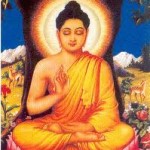Refuge in the Buddha: Man or Myth?
 In most Buddhist traditions, practitioners contemplate The Three Jewels, otherwise known as The Three Gems:
In most Buddhist traditions, practitioners contemplate The Three Jewels, otherwise known as The Three Gems:
- Refuge in the Buddha
- Refuge in the Sangha
- Refuge in the Dharma
The meaning and context of the word refuge in and of itself is worth some thought and consideration, especially to those of us who practice secular Buddhism. In most traditions, refuge is considered faith, faith that what one is being taught is true or valid. But those of us who come from and have rejected religious pasts, faith may cause one to balk. At the least, it should prompt you to question and explore just why and how one takes refuge.
Refuge also represents a place of sanctuary or safety, but how can this apply to the Buddha? How can you have faith or trust in this figure of many centuries ago? I want to explore the first refuge, as answering for the second two seemed easier to me. Refuge in the sangha generally translates in coming to count on the support of your local or virtual Buddhist community. And Refuge in the Dharma opens wide as you get deeper and deeper into practice.
But Refuge in the Buddha was a sticking point for me for a long time. I don’t regard faith as a wise move, yet I did accept a certain amount of trust after reading about and hearing about the Buddha’s teachings. Still, how even can I trust in this man, especially when some of the teachings seemed to contradict themselves?
I found that if I looked at the Buddha as an enlightened man who once taught great wisdom and had all the answers regarding enlightenment that more problems arose than were solved, and refuge was not to be had for me. And as I watched those in my sangha, I started seeing a lot of hero worship, many perceiving the teachings dogmatically. I started feeling reverberations of my childhood religion, outlandish claims that lacked evidence, and it seemed contradicted other teachings and what I was discovering in my own experience.
One day I had decided to reread Genesis in the bible. It struck me powerfully how it read like myth, and it suddenly showed itself as the perfect metaphor for how those in power may try to control you by keeping you ignorant and in the dark! The way out, of course, was only through knowledge. Viewed as metaphor, Genesis revealed poignant meaning and was a red flag for that entire religion!
I wondered then what would happen if I set aside the literal views of the Buddhist canon, of the Buddha himself? What would I gain from the teachings if I took refuge in the Buddha not as a historical figure, a wise man who knew all about enlightenment, but instead as a metaphor, a myth?
My mind opened in new ways as I viewed the Buddha as a metaphor for the teacher within and the teacher from outside (life itself). Buddha came to represent possibilities in many different manifestations from within myself, within each moment, with every second of mindfulness. When it no longer mattered if the canon was truth, and when I looked to it as metaphors and analogies, the contradictions faded away. I could simply discard the absurd as story, and make use of what proved itself valid.
The literal view of rebirth, which never made sense to me, became a metaphor for the birth of feeling of self, the emerging ego, and the dying of such through recognition. Instead of reading a passage and wondering, what in the heck did Buddha mean by this, I saw instead creative possibilities of what the story revealed.
What the truth is regarding Buddha as a historical figure doesn’t matter. Even if I’m wrong, I feel I’m better off erring on the side of this view because to believe the Buddha as a man, a famous historical figure, an all knowing being, is to miss the point of what the Buddha represents within my own practice. In one sutta, even the Buddha says to one young man who is so enamored by him, “You do not see me. You do not see the dharma.”
Taking Refuge in the Buddha as a myth prevents hero worship, prevents getting caught in dogma, prevents confusion over ‘did he mean this or did he mean that?’ Instead, seeing via analogies, metaphor, and myth opens the mind and practice together, and it all dissolves into simply being in the moment, with whatever is present.
After awhile, you realize the Three Jewels: Refuge in the Buddha; Refuge in the Sangha; and Refuge in the Dharma are really just one in the same anyway. There is nothing magical, and there are no boundaries or separation. They are one, as is the whole of existence, all interconnected.
